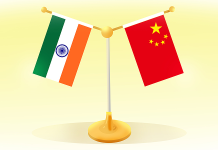
Union Home Minister Amit Shah arrived in Kashmir as part of a three-day visit to Jammu and Kashmir, marking his first trip to the region since the formation of the Omar Abdullah-led National Conference government in October 2024. The visit, which began in Jammu on April 06, underscores the central government’s ongoing commitment to addressing security challenges and fostering development in the Union Territory, particularly in the Kashmir Valley, a region long marked by complex socio-political dynamics.
In This Article:
A Multi-Pronged Agenda
Shah’s itinerary reflects a blend of security reviews, developmental oversight, and symbolic gestures aimed at reinforcing ties with the local populace. Upon arriving in Kashmir on the evening of April 07, the Home Minister made a poignant stop at the family home of Deputy Superintendent of Police Humayun Bhat, a Kirti Chakra awardee killed in a 2023 encounter with terrorists in Kokernag. This visit not only honored the sacrifice of security personnel but also signaled the government’s resolve to support the families of those who serve on the frontlines.
Today, April 08, Shah is scheduled to chair a high-level meeting at Srinagar’s Raj Bhavan to assess the security situation. The meeting includes top officials from the Jammu and Kashmir Police, the Indian Army, paramilitary forces, and intelligence agencies, alongside Lieutenant Governor Manoj Sinha and Chief Minister Omar Abdullah. With recent spikes in militant activity reported in parts of the region, this review is expected to focus on strengthening counter-terrorism measures, securing the Line of Control (LoC), and addressing infiltration attempts from across the border.
In addition to security, Shah is set to evaluate ongoing development projects. The central government has prioritized infrastructure, tourism, and economic growth in Jammu and Kashmir since the abrogation of Article 370 in 2019, and this visit provides an opportunity to ensure these initiatives align with local needs under the new elected government.
Context and Challenges
The timing of Shah’s visit is significant. Jammu and Kashmir has seen a delicate balance of progress and tension in recent years. The restoration of an elected government in 2024, led by the National Conference, has raised hopes for greater political stability, yet demands for the reinstatement of statehood persist. The Home Minister’s presence in Srinagar offers a chance to address these aspirations, though no official statement has confirmed whether statehood discussions are on the table.
Security remains a pressing concern. Despite a decline in large-scale violence since 2019, sporadic attacks and targeted killings continue to challenge the narrative of normalcy. Shah’s visit to a Border Security Force (BSF) outpost in Kathua on April 07 highlighted the government’s focus on border security, particularly in light of reports of cross-border drug trafficking and militancy. His interactions with BSF personnel underscored the need for vigilance in an increasingly volatile regional context.
A Message of Unity and Resilience
Beyond the official meetings, Shah’s visit carries symbolic weight. His engagement with local BJP leaders and workers, which began in Jammu, reinforces the party’s foothold in the region, even as it navigates a complex political landscape dominated by regional players like the National Conference and the People’s Democratic Party. The Home Minister’s public gestures—such as meeting families of martyrs and reviewing compassionate appointments—aim to bridge the gap between New Delhi and the Kashmiri people, a relationship often strained by historical grievances.
Analysts see this visit as part of a broader strategy to project strength and stability ahead of Prime Minister Narendra Modi’s anticipated visit later in April, during which he is expected to flag off the first train to Kashmir from Katra. Ensuring a secure environment for such a landmark event is likely a key priority for Shah and the security establishment.
Looking Ahead
As Amit Shah concludes his Kashmir leg on April 08, the outcomes of his discussions will likely shape the Union Territory’s trajectory in the coming months. For the people of Kashmir, the visit is a moment of scrutiny—will it bring tangible progress on security and governance, or remain a high-profile exercise in optics? For the central government, it’s an opportunity to reaffirm its commitment to a region that remains both a strategic priority and a symbol of national integration.
While the Home Minister’s assurances of development and peace resonate with some, others await concrete steps—be it on statehood, economic opportunity, or an end to violence. As Kashmir stands at this crossroads in April 2025, Shah’s visit is a reminder that the path to stability is as much about dialogue and delivery as it is about determination.
-By Manoj H



